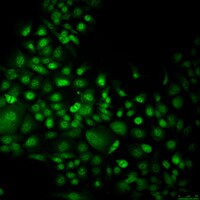SCC626 Sigma-AldrichmEER Mouse E6/E7/hRas Oropharynx Epithelial Cell Line
The SCC626 mEER Mouse E6/E7/hRas Oropharynx Epithelial Cell Line is useful in the study of head and neck squamous cell carcinoma in an immunocompetent, syngeneic animal model.
More>> The SCC626 mEER Mouse E6/E7/hRas Oropharynx Epithelial Cell Line is useful in the study of head and neck squamous cell carcinoma in an immunocompetent, syngeneic animal model. Less<<Recommended Products
Overview
| Replacement Information |
|---|
| References |
|---|
| Product Information | |
|---|---|
| Components |
|
| Quality Level | MQ100 |
| Biological Information | |
|---|---|
| Host | Mouse |
| Cell Line Type |
|
| Physicochemical Information |
|---|
| Dimensions |
|---|
| Materials Information |
|---|
| Toxicological Information |
|---|
| Safety Information according to GHS |
|---|
| Safety Information |
|---|
| Product Usage Statements | |
|---|---|
| Quality Assurance | mEER cells are verified to be of mouse origin and negative for human, rat, Chinese hamster, Golden Syrian hamster, and non-human primate interspecies contamination, as assessed by a Contamination Clear panel by Charles River Animal Diagnostic Services Cells tested negative for infectious diseases against a Mouse Essential CLEAR panel by Charles River Animal Diagnostic Services. Cells tested negative for mycoplasma. |
| Usage Statement |
|
| Packaging Information | |
|---|---|
| Material Size | >= 1 x 10^6 viable cells per vial |
| Transport Information |
|---|
| Supplemental Information |
|---|
| Specifications |
|---|
| Global Trade Item Number | |
|---|---|
| Catalogue Number | GTIN |
| SCC626 | 04065270972705 |
Documentation
mEER Mouse E6/E7/hRas Oropharynx Epithelial Cell Line SDS
| Title |
|---|
Data Sheet
| Title |
|---|
| Data Sheet-SCC626 |












